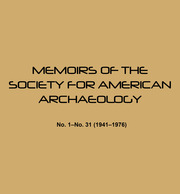No CrossRef data available.
Article contents
Chapter III: Archaeological Sites
Published online by Cambridge University Press: 27 June 2018
Extract
The information about archaeological sites is presented under eight regional sections, seven of which roughly correspond to seven of the tribal subdivisions listed in the third section of Chapter II. The territories of group 5 on the upper Koyukuk and of group 9 on the upper Innoko were not included in our survey. There is, however, an eighth archaeological region, the Yukon near Holy Cross, which yielded specimens of a more pronounced Eskimo character than anything found in the areas above. These sites are, therefore, tentatively listed as “Eskimo.”
In the following sections of this chapter there will be a discussion of all former village sites in the regions covered by our survey, including sites mentioned in the early literature or reported to us. For the convenience of the reader I present below a list of the sites from which specimens were obtained, grouped according to the region in which they are located; their probable age is indicated. The presence of stone adzes and the absence of trade goods of white manufacture are taken as indications that the site was prehistoric, although in most cases, especially where we did little excavating, such an assumption is based on rather inadequate information.
- Type
- Research Article
- Information
- Copyright
- Copyright © Society for American Archaeology 1947
References
1 Bancroft, 1890, pp. 547-554.
2 N. C. Nelson, 1937; Rainey, 1939.
3 Rainey, Letter dated September 24, 1937; Rainey, 1939, pp. 364-371. Workshop sites in the Tanana Valley below Tanana Crossing are at Good Paster River, Chena River near Fairbanks, and Lake Harding (pp. 371-374).
4 Rainey, 1939, pp. 375-376.
5 The dates in parentheses refer to the date of the visit, not of the author's publication. No specific references are given to maps.
6 Whymper, 1869, p. 247.
7 Rainey, Letter dated September 24,1937; Rainey, 1939, pp. 376-378.
8 Dall, 1870, p. 93; Whymper, 1869, p. 236; Jacobsen, 1884, p. 191.
9 Catalogue numbers of the University of Pennsylvania Museum are given in the text only for specimens not illustrated in this report; catalogue numbers of illustrated specimens will be found in the legends accompanying plates and figures.
10 Hrdlička, 1930a, p. 43.
11 Petroff, 1884, p. 12.
12 Dall, 1870, p. 282. He describes it as a stream entering the north side of the Yukon, 65 miles above the “Nowikakat,” or Nowitna River.
13 Hrdlička, 1930a, p. 46.
14 Whymper, 1869, p. 229; Dall, 1870, pp. 78, 282.
15 Petroff, 1884, p. 12.
16 Jacobsen, 1884, p. 192.
17 Zagoskin, (1935), p. 184.
18 Jacobsen, 1884, p. 192.
19 Petroff, 1884, p. 12.
20 Zagoskin, (1935), pp. 174, 177.
21 Jacobsen, 1884, pp. 192, 194.
22 Dall (1870, p. 83) applies the name to Site 2 on the point; Schwatka's map appb'es the name to the hill forming the point, but shows a camp site under the hill; Petroff's Zakatlatan is on the south bank (Site 3); Whymper (1869, p. 226) simply mentions the “fishing village” of Sachertelontin.
23 Jacobsen, 1884, p. 194; Dall, 1870, p. 82.
24 Zagoskin, (1935), pp. 167 f. On the map, Tlialikakat, seems to refer to the lower mouth of the slough connecting Main and Yuto creeks, while an unnamed village is marked on the south bank some distance below Lowden Bend. I believe the map is here in error, for “Tlialikakat” seems to be Jetté's Tsaradal'oten.
25 Dall, 1870, pp. 78 f.
26 Zagoskin (1935), p. 162.
27 Op. cti., pp. 132 f., 163.
28 Op. cit., pp. 133 f.
29 Op.cit., p. 162.
30 Op. cit., p. 135.
31 Op.cit., pp. 136 f.
32 Jettfi, 1908, p. 319.
33 Zagoskin, (1935), pp. 136 f.; Hrdlička, 1930a, pp. 131 f.
34 Dall, 1870, p. 53.
35 Zagoskin (1935), p. 162.
36 Dall, 1870, p. 77.
37 Zagoskin (1935), pp. 131 f., 148, 160, but not located on his map.
38 Hrdlička, 1930a, p. 53.
39 Dall, 1870, pp. 48 ff.; Bancroft, 1890, pp. 572 ff.; The Tena lack chiefs, and their only leaders are shamans, as Jettfi points out.
40 Dall, 1870, pp. 46,49 f.
41 Zagoskin (1935), pp. 122,124,213.
42 Dall, 1870, pp. 64, 282, fig. on p. 65 of “Wolasátux's barrabora.”
43 Zagoskin (1935), p. 121.
44 Hrdlička, 1930a, Fig. 6.
45 Whymper, 1869, p. 190; Dall, 1870, p. 41, “Kaltág.”
46 Zagoskin (1935), pp. 116,124, 198, etc. Hogoltlinde or Nogoltlinde in the translation.
47 Zagoskin (1935), pp. 120, 124.
48 Op. cit., p. 214.
49 Ibid.
50 Op. cit., pp. 216 f.
51 Dall, 1870, p. 211 and text fig.
52 de Laguna, 1934, Fig. 5.
53 Hrdlička, 1930a, p. 54.
54 Dall, 1870, pp. 175 f.
55 de Laguna, 1934, Pl. 71, pp. 177 ff., erroneously published as having been found at Kaltag.
56 Hrdlička, 1930a, pp. 131 f.
57 Whymper, 1869, pp. 264 f.
58 Zagoskin (1935), pp. 218 ff. He also writes of “Wagichagat village on Makaslat, as they call it.” Is this a typographical error for “or Makaslat?”
59 Op. cit., p. 222
60 Dall, 1870, p. 215 and fig. opposite.
61 Hrdlička 1930a, p. 58.
62 Zagoskin (1935), pp. 222 f.
63 Dall, 1870, p. 217.
64 Petrofi, 1884, p. 12.
65 Dall, 1870, pp. 220, 283; Zagoskin (1935), p. 235.
66 Hrdlička, 1930a, pp. 142 f.
67 Op. cit., 1930a, pp. 61, 144.
68 Krieger in Hrdlička, 1930a, pp. 145 ff.
69 Hrdlička, 19306, p. 146.
70 Petroff, 1884, pp. 11 f.
71 Zagoskin (1935), pp. 305-319.
72 Dall, 1870, p. 220.
73 Hrdlička, 1930a, pp. 63 f.
74 Zagoskin (1935), pp. 225 f., 321. A sagen is about 7 feet.
75 Jetté, 1908, pp. 317-320.


